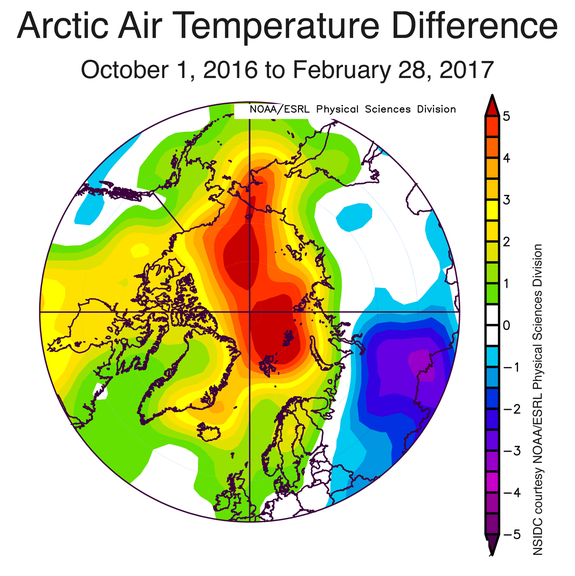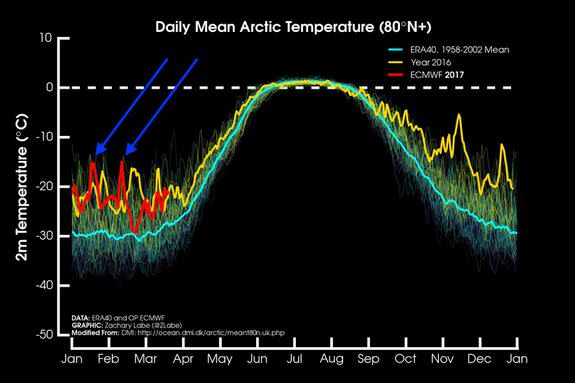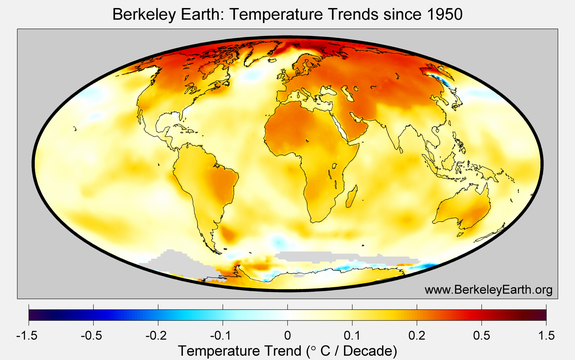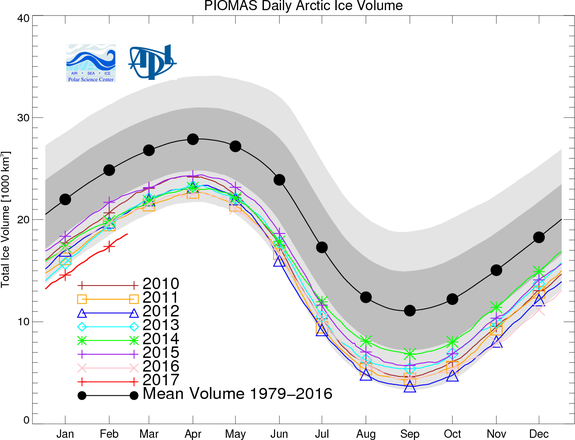Arctic sea ice plunges to record winter low after freak polar 'heatwaves'

Welcome to the new normal: For the third straight year, Arctic sea ice peaked at a record low level during the winter season, scientists said Wednesday.
Arctic sea ice cover reached its annual peak extent on March 7, the National Snow and Ice Data Center (NSIDC) said, at 5.57 million square miles. This is the lowest in the 38-year satellite record, and very likely far longer than that based on other data. This year's peak was about 37,000 miles less than the 2015 record.
When compared to the 1981-2010 long-term average, sea ice extent this year was a staggering 471,000 square miles below the average annual maximum. This means a chunk of ice about the size of Texas, California and Kentucky combined was missing from the top of the world.
SEE ALSO: There are 11 newly-classified clouds, and all of them are breathtaking
The record came at the end of one of the strangest winters that Arctic climate researchers have seen in modern times, with at least four instances in which unusually mild air swept across the entire Arctic from the North Atlantic or Pacific Oceans, bringing the North Pole to near or just above the melting point.

Image: nsidc
NSIDC scientists said air temperatures across the Arctic Ocean averaged more than 4.5 degrees Fahrenheit above average for the five months from October through February, with a series of "extreme winter heat waves" observed as well. Temperatures were even higher, averaging 9 degrees Fahrenheit warmer than normal over large sections of the Chukchi and Barents Seas, the NSIDC found.
Arctic sea ice also hit a record low seasonal peak for sea ice volume, which is a measure of the thickness of the ice. This record indicates that the ice cover present in the Arctic is young and thin, and therefore more susceptible to melting during the upcoming spring and summer, possibly leading to another record low sea ice extent in September.
The last three months were the warmest winter (Dec-Feb) in the #Arctic since record keeping began. pic.twitter.com/LyDPqZhTUl
— Robert Rohde (@rarohde) March 11, 2017
For the season, the Arctic region had the warmest winter on record, according to Berkeley Earth, an independent group that assesses global surface temperature data.
The record warmth across the Arctic, along with the low sea ice extent and volume, is surprising even the most seasoned Arctic researchers.
"All I can say here is that I've been studying Arctic weather patterns for 35 years and have never seen anything like what we've experienced over the past two winters," said National Snow and Ice Data Center (NSIDC) director Mark Serreze, in an email.
"Maybe this is just natural variability, but if so, it is a type of natural variability that I am unfamiliar with."
The record-warm Arctic temperatures and anemic sea ice cover came during the warmest year on record for the Earth as a whole. The Arctic has been warming at about twice the rate of the rest of the world.

Image: zack labe/mashable
As sea ice melts it exposes darker ocean waters beneath it to incoming solar radiation, causing the water temperatures to rise. These milder ocean waters then melt more ice while increasing air temperatures as well, which in turn goes on to melt more ice and snow, exposing more darker surfaces, and so on.
This phenomenon is known as Arctic amplification, and it is having repercussions both throughout the Arctic and beyond.
Not quite Las Vegas
The new adage among Arctic specialists is a twist on the Las Vegas slogan: "What happens in Arctic does not stay in the Arctic."
#Arctic sea ice maximum and #Antarctic minimum both at record low this year. https://t.co/RnAmDjJUqk pic.twitter.com/4P5QzYDF3S
— NSIDC News (@NSIDC) March 22, 2017
Research has shown that Arctic sea ice loss may be changing weather patterns across large portions of North America, Europe and Asia. A study published on March 15 found that sea ice loss is linked to worsening "airpocalypse" events in China, where smog smothers major cities for days, sickening millions.
The absence of fall sea ice cover just north of Russia favors more fall snowfall in parts of Siberia, which influences the placement of high and low pressure areas in ways that contributes to air stagnation across eastern China, the study found.
Until recently, the steepest losses of Arctic sea ice were seen in the summer and fall. But scientists say that winter trends indicate that the sweeping changes taking place in the Arctic are rattling winters there too.
"It is certainly unusual to have 3 winters in a row with very warm Arctic temperatures and record low sea ice conditions," Julienne Stroeve, a senior research scientist at the NSIDC, said via email. "While the winter ice cover has been changing more slowly, these last 3 winters suggest perhaps that the autumn/winter is also starting to respond more."

Image: berkeley earth
The record low winter peak in Arctic sea ice does not mean the upcoming summer melt season will set a record as well. For example, 2016 set a similar record during March but fell short of a record low in September due to weather conditions that favored the retention of sea ice cover in parts of the Arctic.
"The 2017 melt season is starting off in a deep hole," Serreze said. "Will we hence see a new record low ice extent this September? Possibly, but a lot depends on the weather patterns this coming summer, which we can't predict."
Arctic sea ice is declining in all months of the year, with the steepest drop in the summer and fall. Projections show that by the middle of the century the Arctic Ocean could be seasonally ice-free, opening it up to more shipping activity, transits of military vessels as well as fishing and oil and gas drilling activities.

Image: piomas/university of washington
"I think having three consecutive years of low wintertime max records is noteworthy. Additionally, observing long-term sea ice losses in all months is an important factor in a warming Arctic," said Zack Labe, a graduate student at the University of California at Irvine.
Walt Meier, a NASA research scientist, explained the situation more bluntly.
"We’re ending the winter growth season with the sea ice in the worst shape we’ve seen it in our satellite record," he said in an email. "... I’d say the Arctic sea ice is more fragile than it's ever been at this time of year. If we get any kind of extreme summer weather conditions conducive to ice loss, we may well be looking at a record low this summer."
Record low in Antarctica, too
Meanwhile, in the Antarctic, sea ice also set a record low. On March 3, Antarctic sea ice extent hit just 815,000 square miles, the NSIDC found, which was the lowest in the satellite era.
Unlike in the Arctic, though, where sea ice loss is attributable to a mix of human-caused global warming and natural variability, the influences on Antarctic sea ice are more poorly understood.
The geography of these two regions are, in fact, polar opposites, with the Far North situated as an ocean surrounded by land, whereas Antarctica is a continent ringed by sea ice cover at its edges.
"The record lows are not surprising, given Antarctic sea ice extent’s high variability," the NSIDC said in a press release. "Just a few years back, extent in the region set record highs."
In both the Arctic and Antarctic, sea ice melt does not raise sea levels because the ice is already floating. However, the loss of sea ice cover has sped up warming in the Arctic, which has accelerated the melting of glaciers in Greenland and other areas.
